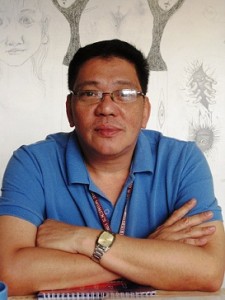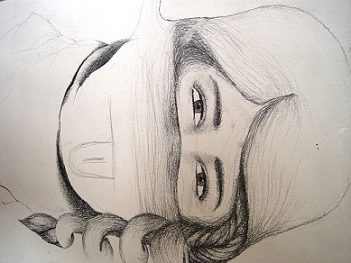Text and photos by ELIZABETH LOLARGA
 IF the once moribund fine arts program of the Philippine Women’s University at the main campus on Taft Avenue, Manila, now enjoys a high profile, a lot of it has to do with its overhauled curriculum, marketing chops and the fairly new PWU School of Fine Arts and Design
IF the once moribund fine arts program of the Philippine Women’s University at the main campus on Taft Avenue, Manila, now enjoys a high profile, a lot of it has to do with its overhauled curriculum, marketing chops and the fairly new PWU School of Fine Arts and Design
(SFAD) Gallery.
Noel Soler Cuizon, visual and performance artist, curator, and fine arts program coordinator, said Francisco “Kiko”Benitez, PWU president, wanted to revive the printmaking tradition of Manuel Rodriguez Sr. Rodriguez once taught at the school and had a print workshop there for him and his students.
Cuizon, himself a PWU graduate, has had several solo and group shows under his belt, had represented the country in art exhibitions abroad. He was once a grantee of the Asian Cultural Council at the San Francisco Headlands Center for the Arts in San Francisco. He also spent time in New York City where he did freelance networking with museum curators and galleries.
The space of the gallery from which one can enter at PWU’s back door on Leon Guinto street was once the same workshop space that another university head, former Sen. Helena Benitez, gave to the Philippine Association of Printmakers (PAP) whose original batch included printmaking vanguards like Virgilio Aviado, Ofelia Gelvezon Tequi, Rodolfo Samonte, among others.
 The younger Benitez wanted a Center for Visual Printmaking along with the gallery so it could exhibit workshop outputs. Printmaker Jesus Flores, who also teaches at PWU, is center director.
The younger Benitez wanted a Center for Visual Printmaking along with the gallery so it could exhibit workshop outputs. Printmaker Jesus Flores, who also teaches at PWU, is center director.
When Benitez presented Cuizon with an offer of gallery space, apart from his helping revitalize the curriculum, the latter’s first thought balloon was: “I’ll turn it into a playground.” Since then, Benitez has not missed a show and has expressed his intention to buy works by students and faculty members. He also looks forward to the gallery collaborating more with the students.
“Ukit,””an exhibition that paid tribute to 100-year-old Rodriguez, was put up and a portfolio of 30/30 prints was gathered featuring works by Ambie Abaño, Aviado, Benjie Torrado Cabrera, Cuizon, Fil dela Cruz, Imelda Cajipe Endaya, Brenda Fajardo, Vic Fario, Jess Flores, Raul
Isidro, Lenore RS Lim, Angelo Magno, Sam Occena and Josephine Torralba. The exhibit and folio were made possible through the school’s collaboration with the group Tutok FOE (Freedom of Expression).
All the participating artists donated their works. Inside the folio are 40 works by 14 artists, some of who are PWU faculty members, the others the old guard and members of the PAP.
There are still some folios on sale at the gallery at a cost of P68,000 each.
Proceeds from these will go to the purchase of facilities and sustaining the center so it can offer workshops and outreach to other communities apart from teaching students etching, intaglio, rubbercut, woodcut, collograph and other print forms.
He said high in the priority of the gallery is showcasing the works of the school’s fine arts students, faculty and alumni. After three years, he foresees the gallery opening its doors to non-PWU artists, too, and becoming more inclusive.
Currently on view until Jan. 3 is “Kamay-an: Works on Paper” with students and teachers alike exhibiting works in boxes with contents as low as P500 a piece. Cuizon said the presentation of the works is such that it “looks like a photo montage.”
 He said the strength of the SFAD curriculum is its balance of art theory and practice. Students have to go through classical drawings and at the same time allowed to experiment towards their senior years. The curriculum is shaped in such a way that students learn visual problem solving and explorations. But it can all be very exhausting when assessment time approaches because PWU is on a grueling trimester schedule.
He said the strength of the SFAD curriculum is its balance of art theory and practice. Students have to go through classical drawings and at the same time allowed to experiment towards their senior years. The curriculum is shaped in such a way that students learn visual problem solving and explorations. But it can all be very exhausting when assessment time approaches because PWU is on a grueling trimester schedule.
Furthermore, Cuizon said, the new curriculum and syllabus fixed the foundation courses, e.g., techniques, materials and visual perception were consolidated and the thesis program geared towards mainstream or industry practice.
Cuizon conducts his thesis and art theory classes at the gallery where the atmosphere is congenial with him serving lunch or snacks. When he joined PWU in 2010, he said there were only three painting majors. Today it has 32 painting majors.
He is proud to see that these majors are united and have formed an official painting organization called Pintab. Their recent activity was a show called “Plan B” because the original artist/s lined up for a show backed out.
What 50 students did on the gallery’s walls were markings using pencil. Some may call it graffiti; some may feel these drawings should’ve been preserved on longer-lasting, non-acidic pieces of drawing paper. But the stress on the ephemeral quality of these markings was the whole point. They were later erased and whitewashed with a new coat of white paint.
